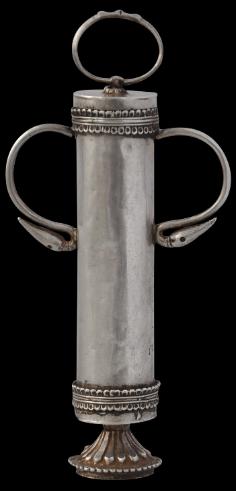Silver Pichkari, India
Inscribed Silver Pichkari for Holi
India
19th century
length: 13.1cm, weight: 66g
This fine silver syringe (pichkari) was used at Holi, the Indian spring festival. It comprises a lotus flower-type head and nozzle that is perforated with many fine holes. The cylinder is decorated at both ends with double bands of small petals. The sides of the cylinder have two prominent finger handles that curve around and finish with bird head-like terminals. The internal plunger which is pulled in and out of the tube to force water out the nozzle also has a fine silver handle.
The tube is engraved with several syllables of devanagari script.
Holi is a popular spring festival, also called the ‘Festival of Colours’, and is celebrated around India. Bonfires are lit at night on the first day. And on the second day, known as Dhulandi, people throw or spray red-coloured powder and water on each other. People also invite one and other to their houses for feasts and celebrations late into the evening.
Originally, the colours used in the
pichkaris came from the flowers of trees that blossomed during spring, such as the Indian Coral Tree and the Flame of the Forest. Both have bright red flowers. Most of the blossoms used were also believed to have medicinal properties. No longer are beautifully made metal pumps such as the one here used today. Instead, cheap plastic pumps are used. Often they are bought from street stalls. No longer do they contain natural colours but pre-mixed industrial dyes.
Several similar silver holi syringes are illustrated in Terlinden (1987, p. 87). These examples are attributed to Rajasthan.
References
Terlinden, C., Mughal Silver Magnificence, Antalga, 1987.
Inventory no.: 1437
SOLD
to see a brass & copper example.





